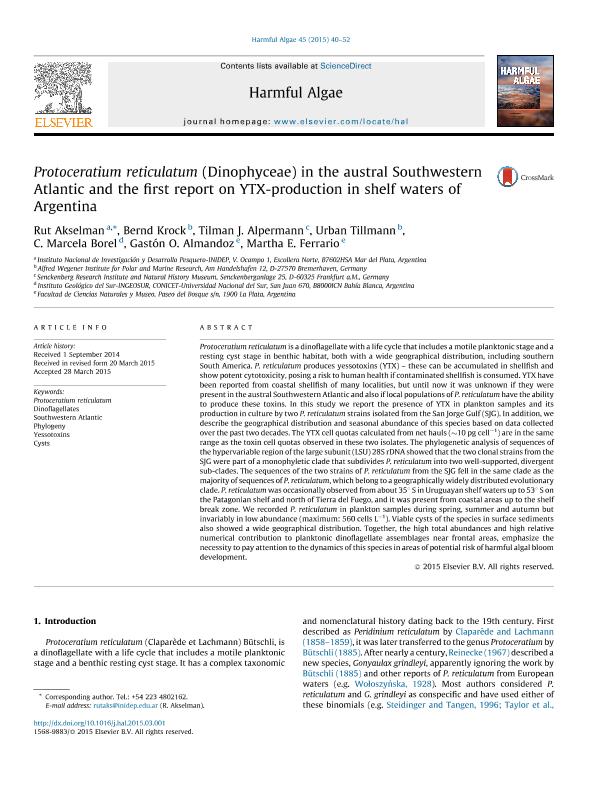Mostrar el registro sencillo del ítem
dc.contributor.author
Akselman Cardella, Rut

dc.contributor.author
Krock, Bernd
dc.contributor.author
Alpermann, Tilman J.
dc.contributor.author
Tillmann, Urban
dc.contributor.author
Borel, Claudia Marcela

dc.contributor.author
Almandoz, Gaston Osvaldo

dc.contributor.author
Ferrario, Martha Elba

dc.date.available
2018-06-07T13:51:25Z
dc.date.issued
2015-05
dc.identifier.citation
Akselman Cardella, Rut; Krock, Bernd; Alpermann, Tilman J.; Tillmann, Urban; Borel, Claudia Marcela; et al.; Protoceratium reticulatum (Dinophyceae) in the austral Southwestern Atlantic and the first report on YTX-production in shelf waters of Argentina; Elsevier Science; Harmful Algae; 45; 5-2015; 40-52
dc.identifier.issn
1568-9883
dc.identifier.uri
http://hdl.handle.net/11336/47636
dc.description.abstract
Protoceratium reticulatum is a dinoflagellate with a life cycle that includes a motile planktonic stage and a resting cyst stage of benthic habitat, both with a wide geographical distribution, including southern South America. P. reticulatum produces yessotoxins (YTXs) which are accumulated in shellfish, show potent cytotoxicity and pose a danger to human health via consumption of contaminated seafood. YTXs have been reported from coastal shellfish of many localities, but until now it was unknown if they were present at the austral Southwestern Atlantic and also if local populations of P. reticulatum have the ability to produce these toxins. In this study we report the presence of YTXs in plankton samples and its production in culture by two P. reticulatum strains isolated from the San Jorge Gulf (SJG). In addition, we describe the geographical distribution and seasonal abundance of this species based on data collected over the past two decades. The YTX cell quotas calculated from net hauls (~10 pg cell?1) are in the same range as the toxin cell quotas observed in these two isolates. The phylogenetic analysis of sequences of the hypervariable region of the large subunit (LSU) 28S rDNA showed that the two clonal strains from the SJG were part of a monophyletic clade that subdivides P. reticulatum into two well supported, divergent sub-clades. The sequences of the two strains of P. reticulatum from the SJG fell in the same clade as the majority of sequences of P. reticulatum, which belong to a geographically wide distributed evolutionary clade. P. reticulatum was occasionally observed from about 35°S in Uruguayan shelf waters up to 53°S in the Patagonian shelf and north of Tierra del Fuego, and it was present from coastal areas up to the shelf break zone. We recorded P. reticulatum in plankton samples from spring to autumn, throughout the warmer period of the year, and invariably in low abundance (maximum: 560 cells L?1). Viable cysts of the species in surface sediments also showed a wide geographical distribution, which, together with high total abundances and high relative numerical contribution to planktonic dinoflagellate assemblages near frontal areas, emphasize the necessity to pay attention to the dynamics of this species in areas of potential risk of harmful algal bloom development.
dc.format
application/pdf
dc.language.iso
eng
dc.publisher
Elsevier Science

dc.rights
info:eu-repo/semantics/openAccess
dc.rights.uri
https://creativecommons.org/licenses/by-nc-sa/2.5/ar/
dc.subject
Protoceratium Reticulatum
dc.subject
Dinoflagellates
dc.subject
Southwestern Atlantic
dc.subject
Phylogeny
dc.subject
Yessotoxins
dc.subject
Cysts
dc.subject.classification
Otras Ciencias Biológicas

dc.subject.classification
Ciencias Biológicas

dc.subject.classification
CIENCIAS NATURALES Y EXACTAS

dc.title
Protoceratium reticulatum (Dinophyceae) in the austral Southwestern Atlantic and the first report on YTX-production in shelf waters of Argentina
dc.type
info:eu-repo/semantics/article
dc.type
info:ar-repo/semantics/artículo
dc.type
info:eu-repo/semantics/publishedVersion
dc.date.updated
2018-06-06T20:46:08Z
dc.journal.volume
45
dc.journal.pagination
40-52
dc.journal.pais
Países Bajos

dc.journal.ciudad
Amsterdam
dc.description.fil
Fil: Akselman Cardella, Rut. Instituto Nacional de Investigaciones y Desarrollo Pesquero; Argentina
dc.description.fil
Fil: Krock, Bernd. Alfred Wegener Institute for Polar and Marine Research; Alemania
dc.description.fil
Fil: Alpermann, Tilman J.. Senckenberg Research Institute and Natural History Museum; Alemania
dc.description.fil
Fil: Tillmann, Urban. Alfred Wegener Institute for Polar and Marine Research; Alemania
dc.description.fil
Fil: Borel, Claudia Marcela. Consejo Nacional de Investigaciones Científicas y Técnicas. Centro Científico Tecnológico Conicet - Bahía Blanca. Instituto Geológico del Sur. Universidad Nacional del Sur. Departamento de Geología. Instituto Geológico del Sur; Argentina
dc.description.fil
Fil: Almandoz, Gaston Osvaldo. Consejo Nacional de Investigaciones Científicas y Técnicas; Argentina. Universidad Nacional de La Plata. Facultad de Ciencias Naturales y Museo; Argentina
dc.description.fil
Fil: Ferrario, Martha Elba. Consejo Nacional de Investigaciones Científicas y Técnicas; Argentina. Universidad Nacional de La Plata. Facultad de Ciencias Naturales y Museo; Argentina
dc.journal.title
Harmful Algae

dc.relation.alternativeid
info:eu-repo/semantics/altIdentifier/doi/https://dx.doi.org/10.1016/j.hal.2015.03.001
dc.relation.alternativeid
info:eu-repo/semantics/altIdentifier/url/https://www.sciencedirect.com/science/article/pii/S1568988315000554
Archivos asociados
